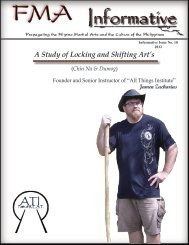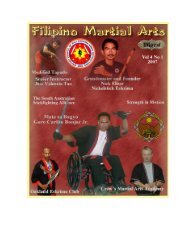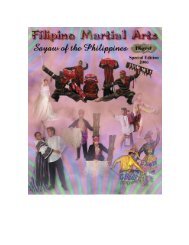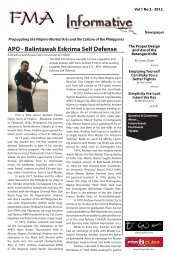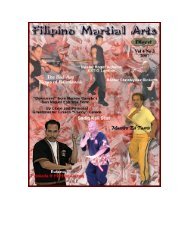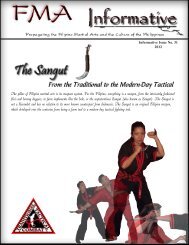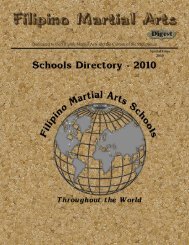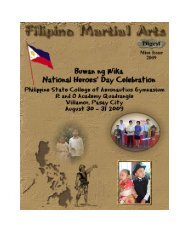Tournaments - FMA Informative
Tournaments - FMA Informative
Tournaments - FMA Informative
You also want an ePaper? Increase the reach of your titles
YUMPU automatically turns print PDFs into web optimized ePapers that Google loves.
Principals of Filipino Empty Hand Fighting<br />
By Guro Joel Huncar<br />
As a practitioner of Filipino Martial Arts I used to get frustrated by the fact that<br />
when I tell people I teach Arnis they usually say, "Oh, you are a stick fighter". To which I<br />
used to reply, "yes, stick fighting is a part of what I teach, but not all of it". Usually the<br />
person to whom I would be talking would get a puzzled look on their face and then they<br />
would say something like, "oh so what else do you teach, 'Kerrotty' or something?” After<br />
a few hundred of these conversations I now look at the person and smile and say, "yes I<br />
teach stick fighting". Often people only want to believe what they already know, even if<br />
it is wrong.<br />
Those of us who practice Filipino martial arts know that arnis/kali/eskrima are<br />
fighting arts period and not just stick fighting arts. In fact while the stick is potentially a<br />
great weapon, it's greatest use is to familiarize Arnisadors on lines of attack and how to<br />
move combatively. In other words the stick is secondary to the skills it develops. ("But<br />
you still are teaching stick fighting...right?") In fact, Master Dan Rutano once told me<br />
that many old time Arnisadors would say, "If you know single stick, you know all there is<br />
to know about fighting". This is a hard concept to swallow for those of us who see the<br />
stick as simply a stick or a sword.<br />
Through training with the single stick the Arnisador learns all the basic<br />
ingredients of his art. Footwork, body angling, blocking and deflection, limb<br />
immobilization and trapping, striking with power, limb destruction, grappling and<br />
clinching and co-ordination are all learned through singlestick training. This is much<br />
deeper then "stick fighting".<br />
This is one of the most important principals of Filipino martial arts and especially<br />
Filipino empty hand. All movement is universal, so the basic move with a weapon is the<br />
same with empty hands. Of course you have to adapt the movement to make it work, but<br />
once this principal is truly understood it is very easy to apply.<br />
A block and check with the stick on angle one becomes a block and check with<br />
the hands. A counter cut with the knife can be a muscle destruction with the hand. It is<br />
really quite simple, and once you have trained your body to move one way with the stick,<br />
you can very easily adapt and move the same way with empty hands. With a little<br />
knowledge and training these empty hand movements become very devastating and<br />
deadly. An Arnisador is never unarmed once he or she has developed a true<br />
understanding of their art.<br />
Footwork remains the same with a weapon or without. The Arnisador is still<br />
trying to reach a position of advantage usually on the outside of an opponent. This is<br />
because by being on the outside you take away two of the opponents limbs. For example<br />
if I check the right elbow of an adversary as I move to his right, I can keep his left leg and<br />
left arm out of the fight until he catches up and changes his body angle. I will be trying<br />
to stop him from doing so by maintaining pressure on him and blitzing him with an<br />
onslaught of all my weapons or putting him on the ground with a throw or sweep.<br />
The check to the right elbow is an example of a simple trap. Trapping in <strong>FMA</strong> can<br />
be that simple or as advanced as some of the Wing Chun style traps. Limb binding and<br />
trapping are trained in such drills as Cadena de Mano and Hubad Lubad.



